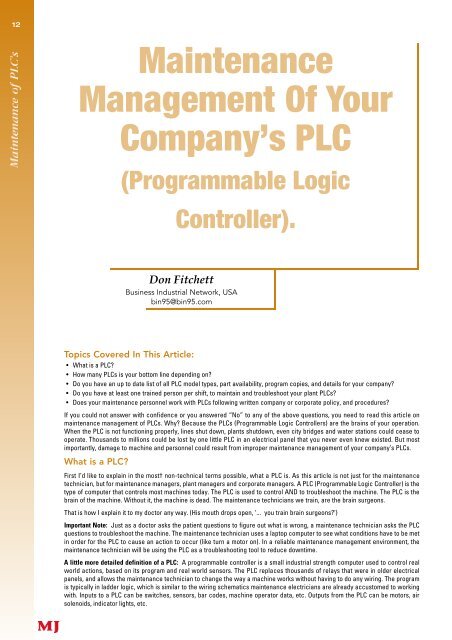October - Library - Central Queensland University
October - Library - Central Queensland University
October - Library - Central Queensland University
You also want an ePaper? Increase the reach of your titles
YUMPU automatically turns print PDFs into web optimized ePapers that Google loves.
12<br />
Maintenance<br />
Management Of Your<br />
Company’s PLC<br />
Don Fitchett<br />
Business Industrial Network, USA<br />
bin95@bin95.com<br />
Topics Covered In This Article:<br />
• What is a PLC?<br />
• How many PLCs is your bottom line depending on?<br />
• Do you have an up to date list of all PLC model types, part availability, program copies, and details for your company?<br />
• Do you have at least one trained person per shift, to maintain and troubleshoot your plant PLCs?<br />
• Does your maintenance personnel work with PLCs following written company or corporate policy, and procedures?<br />
If you could not answer with confidence or you answered “No” to any of the above questions, you need to read this article on<br />
maintenance management of PLCs. Why? Because the PLCs (Programmable Logic Controllers) are the brains of your operation.<br />
When the PLC is not functioning properly, lines shut down, plants shutdown, even city bridges and water stations could cease to<br />
operate. Thousands to millions could be lost by one little PLC in an electrical panel that you never even knew existed. But most<br />
importantly, damage to machine and personnel could result from improper maintenance management of your company’s PLCs.<br />
What is a PLC?<br />
(Programmable Logic<br />
Controller).<br />
First I’d like to explain in the most† non-technical terms possible, what a PLC is. As this article is not just for the maintenance<br />
technician, but for maintenance managers, plant managers and corporate managers. A PLC (Programmable Logic Controller) is the<br />
type of computer that controls most machines today. The PLC is used to control AND to troubleshoot the machine. The PLC is the<br />
brain of the machine. Without it, the machine is dead. The maintenance technicians we train, are the brain surgeons.<br />
That is how I explain it to my doctor any way. (His mouth drops open, ‘... you train brain surgeons?’)<br />
Important Note: Just as a doctor asks the patient questions to figure out what is wrong, a maintenance technician asks the PLC<br />
questions to troubleshoot the machine. The maintenance technician uses a laptop computer to see what conditions have to be met<br />
in order for the PLC to cause an action to occur (like turn a motor on). In a reliable maintenance management environment, the<br />
maintenance technician will be using the PLC as a troubleshooting tool to reduce downtime.<br />
A little more detailed definition of a PLC: A programmable controller is a small industrial strength computer used to control real<br />
world actions, based on its program and real world sensors. The PLC replaces thousands of relays that were in older electrical<br />
panels, and allows the maintenance technician to change the way a machine works without having to do any wiring. The program<br />
is typically in ladder logic, which is similar to the wiring schematics maintenance electricians are already accustomed to working<br />
with. Inputs to a PLC can be switches, sensors, bar codes, machine operator data, etc. Outputs from the PLC can be motors, air<br />
solenoids, indicator lights, etc.
















